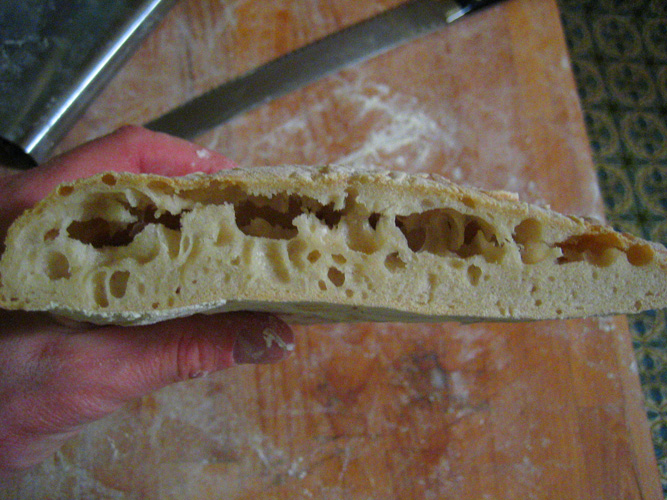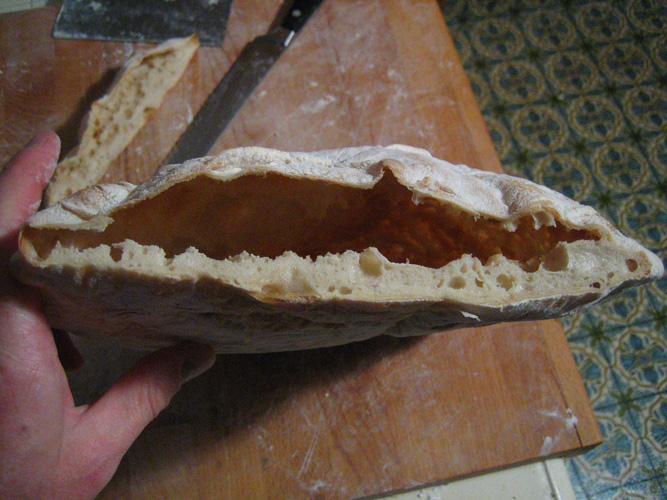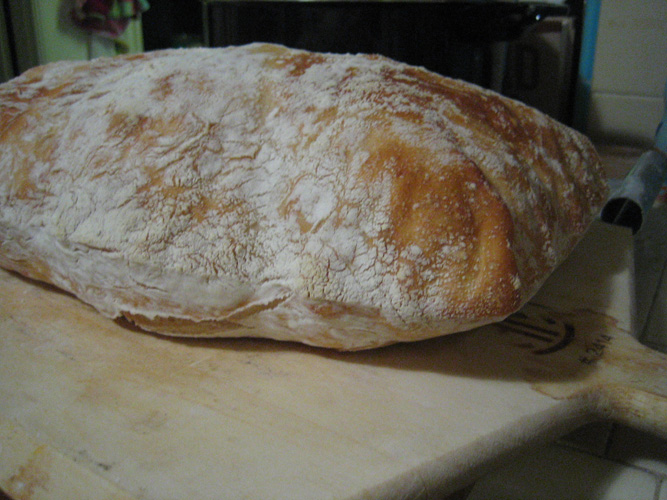I've been playing around with the no-knead ciabatta recipe for a while, and am finding a major problem: my ciabatta comes out with one giant air pocket. Last night I made three loaves all from the same 100% hydration recipe. With the first I stirred the 18-hour proofed batter then poured out one loaf and put it right in the oven. Here's how that one came out.

You can see even with no proofing time it got pretty large bubbles and most are at the top. About 2/3 of this loaf had one giant bubble at the top, so you end up with a really thin top crust.
The second loaf I proofed for 45 minutes, then flipped upside down and baked right away. I thought this might help redistribute the air pockets to the bottom so they'd rise through the bake and you would get a nicely uniform webbed structure. Nope. Even worse.

The final loaf proofed uncovered for about 90 minutes, didn't get flipped, and came out with the most dramatic structure yet.

I haven't cut that one open yet but I expect it'll be like the Christmas turkey in National Lampoon's Christmas Vacaction--all brown skin and hollow inside.
So what gives? Is 100% hydration dough just impossible to bake? I know there's too much flour on all but the last loaf, which affects browning. I'm thinking the batter is so thin that the bubbles instantly rise to the top and the use of high-gluten flour means the crust just stretches out like a latex balloon. Should I switch to all-purpose or just lower the hydration to 85-90%?
I've got the recipe on the bread section of my website so you can see the formula in detail. I think it still needs some tweaking!
Peter
That or a weak flour. But it's clear your dough doesn't have sufficient structure to develop a proper crumb. Instead, the steam is just concentrating in one giant bubble.
I would highly suggest using high gluten bread flour, 5 minutes mixing with around 75% hydration, and then an overnight retard in the fridge. Bring up to temp around 2-3 hours, then cut and stretch into the shape and proof for another hour or two to develope the pockets. More or less like the BBA Ancienne. That should work.
What you've got looks a lot more like pita bread than ciabatta. I haven't made no-knead ciabatta, so I can't speak to that technique. However, if you're literally 'pouring' the mix out, then it's too wet IMHO. Ciabatta greatly benefits from folding as a way of developing strength and trapping the gases within to create a lovely open crumb structure. Without folds, I don't know how you're going to get a good crumb structure.
Most of my ciabatta is in the mid to high 70% range, which means that while it's a wet dough, it's certainly capable of taking folds.
You might want to back off the hydration level and try incorporating folds.
I'm not at all sure that high gluten flour is appropriate to ciabatta by the way.
Larry
You're right, it's a lot like pits but isn't evenly distributed. I'm using a 50/50 blend of bread flour and high-gluten, and trust me, the dough is plenty strong. Otherwise I think it would crack open or split before it puffed up, so I don't think gluten development is the problem. I'm still leaning toward hydration level, but I'm going to do another test this week to find out. I just need to eat my way through the first two loaves before I make more!
-Peter
http://psoutowood.wordpress.com
"Otherwise I think it would crack open or split before it puffed up"
I don't think that's true at all. When a loaf of bread hits the oven, the outer skin begins to set first, which traps the steam, forming that huge bubble.
No, the fact that you have one giant pocket and a bunch of teeny tiny holes *really* says to me it's a problem with the gluten structure, otherwise you'd expect *some* additional bubbles, and there's basically none of note.
Given that you're using an 18-hour proof, maybe you're overproofing the dough (overproofing will result in a breakdown of gluten structure). Try cutting down the proofing time and see what happens.
Thanks everyone for the good suggestions. I dropped the hydration from 100% to 89%, which oddly didn't seem to change the consistency of the dough. It TOTALLY fixed the air pocket problem, however. Check out the new structure:
There's much more gelatinazation of starches, the bubbles are even throughout, and the structure is strong. I also baked this a little hotter, at around 550, which gave a nice brown and crispy crust. No steaming, since the dough is so wet I think it self-steams and fills up the oven.
But here's the, I think, even more interesting part. That ciabatta shown above was poured straight from the bowl after I mixed it. No proofing, no flour dusting, just straight onto parchment and baked. I did another loaf with a 1-hour proof, flipping it over before baking and fully flouring it. It's a big pain to do this, and once the dough is coated in flour it doesn't brown well. Plus I don't like tasting that much flour on the crust. I didn't notice any difference in taste between the two, maybe because it's a no-knead and sits out for 18 hours anyway to develop flavor and structure. Bottom line: no-knead with no-proof and 89% hydration seems to work great! I updated the recipe on my blog for those who want to try it for themselves. You can find it here. Happy baking!
-Peter
http://psoutowood.wordpress.com